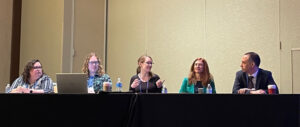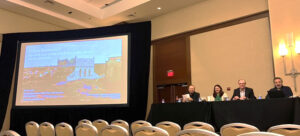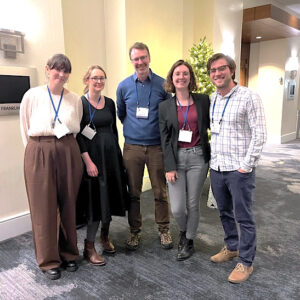
Historians of the University of North Carolina at Chapel Hill took on the 2023 Annual Convention of the Association for Slavic, East European, and Eurasian Studies (ASEEES) in exceptionally strong numbers. Presenting their work, chairing panels, and commenting on new research of their colleagues, nine Carolina historians—three faculty members (Chad Bryant, Karen Auerbach, Eren Tasar) and six graduate students—participated in the total number of twelve panels.
This year’s convention, which took place from November 30 to December 2 in Philadelphia, celebrated the 75th anniversary of ASEEES, the largest international scholarly society advancing knowledge about Central Asia, the Caucasus, Russia, and Eastern Europe, with the theme of decolonization. Calling for the re-evaluation of long-established hierarchies, the organizers encouraged scholars to explore decolonization as a contemporary and historical force and to reexamine the power relationships embedded in our research, professional practices, and teaching.

Luke Jeske kicked off the UNC line-up with his presentation on pilgrimages of Russian Orthodox Christians to the Holy Lands in the second half of the long 19th century. His paper shed light on the emerging institutional support of these voyages, pointing to institutional relationships of collaboration and contestation. He argued that studying the origins of pilgrimage as a modern mass phenomenon reveals broader trends of increasing mobility both within the Russian Empire and beyond it.
 Oskar Czendze also captured the audience’s attention with a story of migration. Examining the ways in which Jewish immigrants in New York’s Lower East Side imagined their former homeland, the Habsburg province of Galicia, Czendze highlighted the ways in which the First World War functioned as a catalyst in Galicia’s reinvention as a place of Jewish pride. In doing so, he highlighted the integrating force of regionalism for the creation of American-Jewish identity among Galician Jewish immigrants.
Oskar Czendze also captured the audience’s attention with a story of migration. Examining the ways in which Jewish immigrants in New York’s Lower East Side imagined their former homeland, the Habsburg province of Galicia, Czendze highlighted the ways in which the First World War functioned as a catalyst in Galicia’s reinvention as a place of Jewish pride. In doing so, he highlighted the integrating force of regionalism for the creation of American-Jewish identity among Galician Jewish immigrants.
Seeking to reframe fundamental questions of Habsburg military history, Kevin Hoeper examined how the Habsburg army sought to popularize mandatory military service in the late nineteenth and early twentieth centuries. Examining sources from the Czech lands, Hoeper focused on the army’s idealized rhetoric of the “local regiment” as a propagandistic instrument. The goal was to frame mandatory military service as a familial birthright and an exercise in local patriotism. In the end, he argued, the “local regiment” evolved into a flexible tool for appealing to the military-aged youth of the multinational empire.

Moving into the age of extremes, Tess Megginson’s paper focused on the Czech mapmaker Viktor Dvorský and the ways in which he constructed his geographical imagination of an independent Czech and Slovak state during the First World War. Megginson analyzed his publications leading up to 1918 to examine how Czech nationalist discourse entered his thinking as he created arguments for the geographical basis for an independent Czechoslovak state. Overall, she argued that Czech mapmakers revolutionized mental maps at a time when borders seemed malleable and fluid.
Examining the impact of the new borders, Zora Piskačová demonstrated the rather tense relationship between the municipal leaders of Polish Cieszyn and Czech Český Těšín and their respective nation-states. She presented alongside Tereza Juhászová—a result of the international cooperation between the History Department at UNC-CH and the Institute of International Studies at Charles University in Prague (Czechia) instigated by Professor Chad Bryant. Piskačová was also awarded the Graduate Student Research Award of the Polish Studies Association during their annual meeting.
Finally, turning to the period following the Second World War, Mira Markham introduced her work on communist attempts to appropriate the 9th century figures of Byzantine Christian theologians and missionaries, Sts. Cyril and Methodius, as pillars legitimizing the Stalinist order in the early 1950s. Markham’s paper revealed the relative flexibility of the Czechoslovak communist regime in its early years and highlighted a particular and often overlooked Moravian Catholic vision of the Czech national identity.

All in all, the convention was valuable to the Carolina historians beyond the chance to present their work. “It was my first time attending ASEEES, and I’m so grateful to have gone,” says Tess Megginson. “It was a little overwhelming at first since it was like seeing my bookshelf come to life in front of me… But I was surprised at how approachable and generous everyone was with their time. It was great to meet scholars I’ve looked up to for some time, as well as other graduate students who could give advice on navigating conferences like this. I’m already counting down the days until next year in Boston!” Indeed, quite of few of this year’s attendees are already planning panel for the 2024 Annual Convention which will take place in Boston, MA—see you all there!
-Zora Piskačová
I’d like to thank Tess Megginson and Oskar Czendze for sharing their photos with me.
